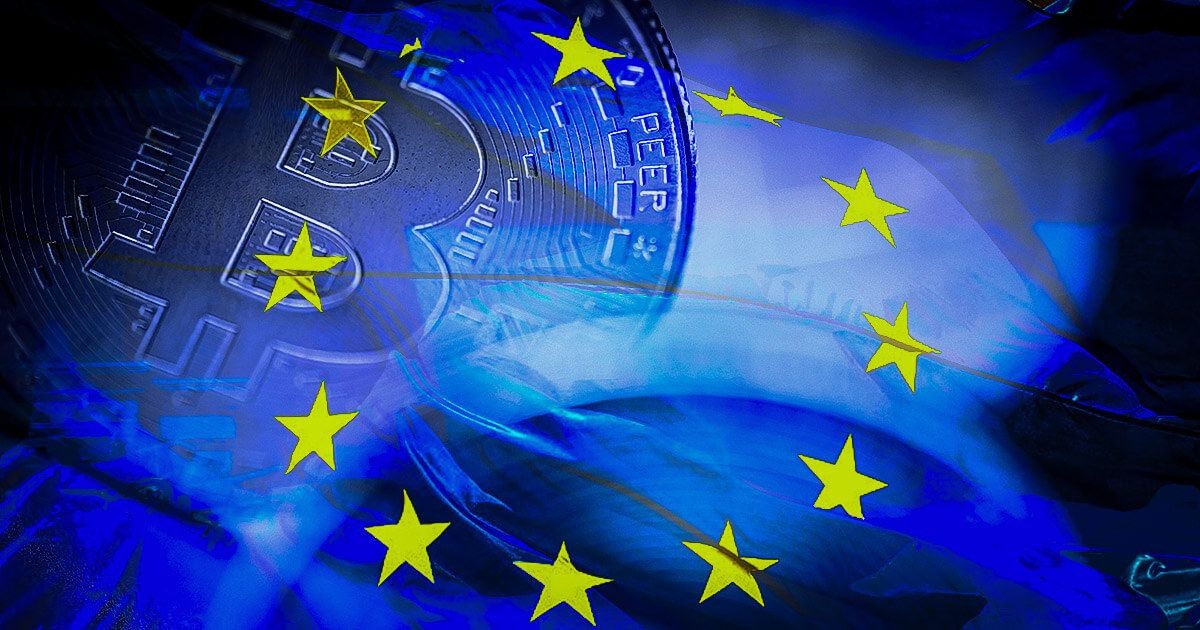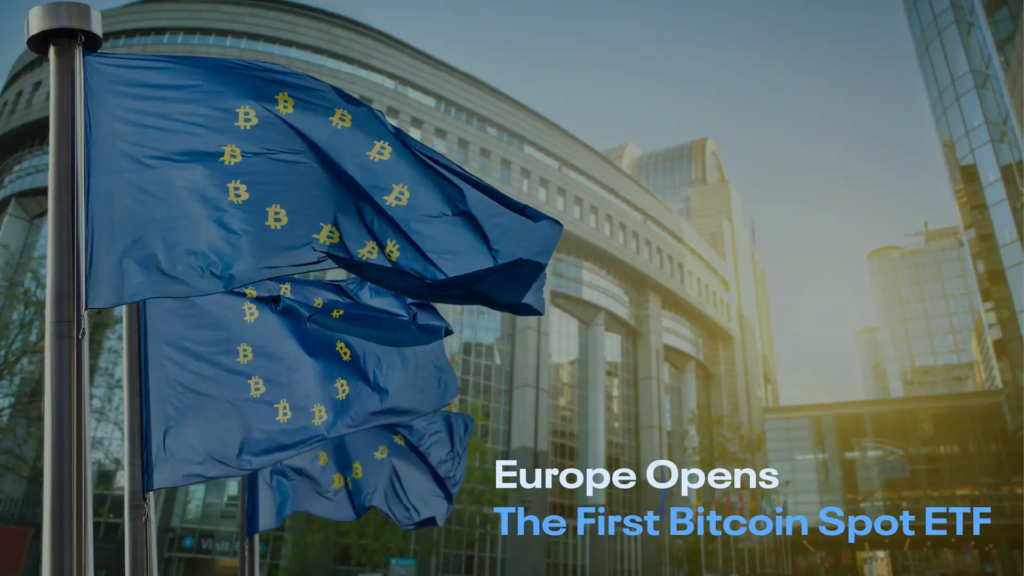Exploring the Future of Bitcoin ETFs in the European Union: Opportunities and Challenges
Navigating the European Union’s investment scenario, one might wonder: are direct Bitcoin ETFs a possibility in an environment dominated by UCITS regulations? This article addresses that primary concern, highlighting current alternatives like Bitcoin ETNs and scouting the horizon for future investment vehicles in the EU’s digital asset space. Stay with us as we distill the EU regulatory essentials and ponder the role of Bitcoin ETFs in the European Union, considering their potential impact on European portfolios.
Key Takeaways
- The stringent UCITS regulations in the EU, which require diversified investment portfolios, have prevented the launch of spot Bitcoin ETFs, driving investors towards alternative crypto investment vehicles like Bitcoin ETNs.
- Although the regulatory environment in the EU is complex, it presents opportunities for the creation of diversified crypto ETFs incorporating multiple cryptocurrencies within the UCITS framework, balancing innovation and investor protection.
- The European Securities and Markets Authority (ESMA) is considering the inclusion of crypto assets in the UCITS market, which could significantly influence the EU’s investment landscape and further boost the capital inflow into the crypto market.
The Current State of Bitcoin ETFs in the EU

Investors across the European Union have long eyed the burgeoning crypto market, eager to dip their portfolios into the digital asset class. However, a direct path to Bitcoin ETFs remains elusive, largely due to the stringent UCITS regulations, which mandate a spread of investment risks across multiple assets. This regulatory stance has kept pure Bitcoin ETFs at bay, compelling investors to seek alternative routes to gain exposure to the volatile allure of the cryptocurrency market.
Despite the absence of spot Bitcoin ETFs, the European investment landscape is far from barren. Alternative vehicles, such as Bitcoin ETNs, have sprouted, providing investors with regulated paths to include Bitcoin in their investment strategies. These workarounds, while not bitcoin spot ETF in the strict sense, are emblematic of the European market’s adaptability and resilience in the face of regulatory hurdles.
UCITS Regulations and Their Impact on Bitcoin ETFs
75% of EU retail investors’ collective investment is underpinned by UCITS funds, which mandate a diversified strategy, thus excluding a single-asset focus like a Bitcoin ETF. The UCITS Eligible Assets Directive, with ESMA’s oversight, ensures the safeguarding of investor interests and the quality of retail investment products, posing a formidable barrier to the approval of Bitcoin-only ETFs in Europe. Consequently, these measures create a complex environment for European investors, restricting their ability to directly invest in single-asset cryptocurrency ETFs, unlike their US counterparts.
These regulations, with their stringent criteria for liquidity, risk diversification, and net asset value calculations, not only prevent the creation of such funds but also raise significant custody issues due to the unique requirements for holding crypto assets. It’s a dichotomy that underscores Europe’s cautious, yet protective, stance towards retail investors looking to venture into the high-risk, high-reward domain of cryptocurrencies.
Alternative Investment Options: Bitcoin ETNs
In the face of these regulatory constraints, investors have found solace in Bitcoin exchange-traded notes (ETNs), a type of transferable securities. These investment vehicles, available on European exchanges, offer a straightforward and regulated avenue for integrating Bitcoin into diversified portfolios. Firms like 21Shares, VanEck, and ETC Group have emerged as providers of Bitcoin ETNs, demonstrating a robust market response to investor demand for cryptocurrency exposure.
The ETN structure allows investors to invest directly in Bitcoin through a product that tracks the performance of the underlying asset—akin to ETFs but circumventing the UCITS restrictions. This ingenious solution cater to the European interest in cryptocurrency investment while complying with the existing regulatory framework, demonstrating the adaptability of the crypto market.
The Potential for Diversified Crypto ETFs in Europe

As Europe grapples with the crypto conundrum, the potential for diversified crypto ETFs glimmers on the horizon. Leveraging the existing UCITS framework, which already underpins the vast majority of collective investments, Europe could pave the way for ETFs that encompass multiple cryptocurrencies through recognized indexes. This approach would sidestep the need for immediate regulatory overhauls and provide a prudent path forward for crypto ETFs in the EU.
The concept combines the traditional advantages of diversification with the innovative vigor of the crypto market. By crafting portfolios that span various digital assets, European investors could mitigate risks and tap into a broader spectrum of the cryptocurrency market’s potential. This intriguing idea could potentially propel Europe ahead of other regions in the integration of crypto assets into mainstream investment vehicles.
Benefits of Diversified Crypto ETFs
Diversified crypto ETFs could be the golden ticket for European investors seeking stability in an otherwise tumultuous market. Spreading investments across a range of crypto assets, these ETFs could offer a more balanced portfolio, tempering the volatility inherent to individual cryptocurrencies. Furthermore, investors could gain exposure to various sectors within the crypto universe, from DeFi to smart contracts, capturing a slice of the industry’s expansive growth trends.
The appeal of diversified crypto ETFs in Europe is not merely theoretical. With UCITS-compliant products that leverage established crypto indexes, these investment vehicles could provide a convenient, less volatile entry point into the crypto space. This persuasive proposition has the potential to transform the investment landscape, bridging the gap between the daring world of cryptocurrencies and the proven principles of traditional asset management.
Challenges and Risks Associated with Crypto ETFs
However, the road to diversified crypto ETFs is not without its pitfalls. Crypto markets are notorious for their rapid shifts in leadership and performance disparities, which can result in significant underperformance for portfolios that lack adequate diversification. Moreover, the dynamic nature of crypto assets often necessitates frequent rebalancing of concentrated ETF portfolios, introducing additional complexity and potential costs.
Some of the challenges in creating diversified crypto ETFs include:
- Rapid shifts in leadership and performance disparities in crypto markets
- Underperformance for portfolios that lack adequate diversification
- The need for frequent rebalancing of concentrated ETF portfolios
Despite these challenges, the potential benefits of diversified crypto ETFs make them an attractive investment option for many investors.
These challenges underscore the delicate balance required to navigate the crypto ETF landscape. Investors must be prepared to adjust their strategies swiftly to respond to market movements, all while maintaining a vigilant eye on the costs and complexities that such adjustments entail. This balancing act requires agility and expertise, as both European investors and regulators strive to harness the potential of crypto ETFs without falling prey to their inherent risks.
Europe’s Leadership in Diversified Crypto Investment Products

While grappling with regulatory intricacies, Europe has emerged as a leader in the crypto investment arena, offering a diverse array of products that cater to both retail and institutional investors. From exchange-traded notes to single asset products and liquid staking offerings, the European market stands out for its breadth and depth of cryptocurrency investment options. This commitment to diversification is a testament to Europe’s forward-thinking approach, attracting a broad spectrum of investors and solidifying its position at the forefront of the global crypto investment sector.
The region’s pioneering spirit is palpable, as Europe continues to innovate within the confines of its regulatory frameworks. Europe confidently and strategically negotiates the delicate balance between consumer protection and market development. The resulting environment is one of robust investment opportunities, providing a fertile ground for both seasoned investors and newcomers to the crypto market.
Examples of European Crypto Investment Offerings
Take 21Shares, for example, a firm that epitomizes Europe’s crypto investment prowess. Offering an array of products that include indexes, single asset products, and liquid staking propositions, 21Shares has carved out a niche in the market, backed by physical spot crypto assets. With around 40 global products under its belt, the firm provides an insight into the extensive range of investment options tailored to meet the diverse needs and risk appetites of European investors, while adhering to market practices.
Moreover, risk mitigation in these offerings involves regulated crypto custodians and independent security trustees, adding a layer of safety for investors navigating the volatile crypto waters. These examples underline the sophistication and maturity of Europe’s crypto investment landscape, where innovation is matched by a robust regulatory safety net—a combination that resonates with investors and sets Europe apart on the global stage.
Factors Contributing to Europe’s Leadership in Crypto Investments
Europe’s ascendancy in the crypto investment domain is no accident. The result of a stringent regulatory environment that favors the development of diversified products over single-asset ones, thus cultivating a healthy ecosystem for crypto investments. Further fueling this leadership is Europe’s deep well of technical expertise, which nurtures the growth of cutting-edge decentralized applications and Web3 services.
These factors converge to create an environment where crypto investments can flourish under the watchful eyes of regulatory bodies. This scenario augurs well for the future of crypto ETFs in Europe, providing an insight into a market that equally values innovation and investor protection. As the EU continues to strengthen its position, it sets a benchmark for others to follow, blending technical ingenuity with sound regulatory practices.
ESMA and the Future of Crypto Assets in the €12 Trillion UCITS Market

The €12 trillion UCITS market in European finance stands colossal, overshadowing the US Bitcoin ETF market. In this vast arena, the European Securities and Markets Authority (ESMA) plays a critical role, assessing the viability of including crypto assets in UCITS funds. With a Call for Evidence, ESMA is currently weighing the risks and benefits of such an inclusion, soliciting stakeholders’ insights into the potential integration of crypto into this prominent investment market.
The implications of ESMA’s review are profound, with the potential to unlock a new era of crypto asset allocation within Europe’s investment landscape. A positive outcome could lead to broader market access and increased liquidity for crypto assets, as funds within the UCITS framework would no longer require individual authorization for each crypto investment. The ripple effect could be more significant than the impact of U.S. Bitcoin ETFs, marking a pivotal moment in the history of crypto assets and digital finance.
ESMA’s Role in Assessing Risks and Developing Technical Advice
As guardian of the markets, ESMA is tasked with a comprehensive review of UCITS fund eligibility criteria, a framework untouched since 2007, which may soon encompass crypto-assets. This rigorous analysis aims to ensure that any integration of cryptocurrencies into UCITS funds aligns with liquidity requirements and protects the interests of investors. With technical advice and feedback from trade associations and stakeholders, ESMA’s role is pivotal in shaping the future of crypto ETFs in Europe.
This methodical approach reflects the EU’s commitment to thoroughness and due diligence, ensuring any regulatory adaptations are made with a full understanding of the implications for the market. ESMA’s work will lay the groundwork for potentially significant shifts in how crypto assets are perceived and handled within the EU’s financial system, setting a precedent for other regulatory bodies worldwide.
Implications for the Crypto Market and Digital Assets
Incorporating crypto assets into the UCITS market could signal the beginning of a new era for digital finance in Europe. With funds potentially allocating a small portion of their liquidity to cryptocurrencies, the impact could be more significant than any developments in the U.S. Bitcoin ETF market. Although UCITS funds are subject to investment limitations, the inclusion of a modest percentage of crypto assets in their portfolios could lead to a significant influx of capital into the crypto sphere.
This advancement could improve market access and firmly establish blockchain technology as a key component of the financial ecosystem. While the EU is dealing with the complexities of integrating crypto into traditional finance, the stakes are high, but so are the potential benefits. The outcome of ESMA’s review could set a new standard for crypto investments, influencing market dynamics and bolstering confidence in digital assets.
Regulatory Landscape and the Path to Bitcoin ETF Approval in the EU

The regulatory landscape in the European Union consists of various efforts to harmonize the integration of digital assets into the financial market. The Markets in Crypto Assets Regulation (MiCA), established in June 2023, is a cornerstone in this endeavor, targeting fraudulent activities among crypto issuers and traders without directly regulating Bitcoin itself. Meanwhile, the European Commission is diligently crafting a pro-innovation legal framework for digital assets and smart contracts, focused on legal certainty and consumer protection.
These regulatory shifts are closely tied to the journey towards Bitcoin ETF approval in the EU. The decentralized nature of Bitcoin and concerns over its environmental impact contribute to a cautious approach by EU financial regulators, in stark contrast to the U.S. Securities and Exchange Commission’s approval of 11 spot Bitcoin ETFs, showcasing their stance on the exchange commission.
Thus, the EU’s path to integrating Bitcoin ETFs is a complex tapestry, interwoven with innovation, regulation, and environmental consciousness.
The European Central Bank’s Stance on Crypto Assets
The European Central Bank (ECB) scrutinizes Bitcoin, viewing it more as a medium for illicit transactions rather than a safe investment vehicle. This perspective reflects the ECB’s broader concerns about the role of crypto assets in the financial ecosystem and the potential risks they pose to market stability. Though the SEC’s approval of Bitcoin spot ETFs marked a significant regulatory milestone, the ECB’s reservations highlight the divergent views on cryptocurrency’s place within the financial landscape.
Interestingly, the market response to the SEC’s authorization of Bitcoin spot ETFs was a rally, hinting at a disconnect between regulatory skepticism and investor enthusiasm. This disparity underscores the complexity of the regulatory environment surrounding cryptocurrencies and the challenges that lie ahead as Europe considers the future role of Bitcoin ETFs.
The European Securities and Markets Authority’s Approach
The European Securities and Markets Authority (ESMA) plays a pivotal role in the EU’s regulatory response to cryptocurrencies. As part of the Markets in Crypto-Assets Regulation, ESMA has finalized rules for crypto-asset service providers, aiming to enhance competition and investor protection. ESMA’s cautious approach to Bitcoin regulation, born of the asset’s non-traditional nature and complex guidelines, has resulted in persistent regulatory uncertainty.
Through consultations with industry experts and stakeholder feedback, ESMA is assessing the feasibility of incorporating cryptocurrencies into UCITS investment products, a critical step towards the potential approval of Bitcoin ETFs in Europe. This careful, consultative process is emblematic of the European approach to financial innovation, where regulatory prudence meets market potential.
Blockchain Technology and Its Influence on the Crypto Market
Blockchain technology, the foundation of the cryptocurrency market, provides secure and transparent transaction processing through a decentralized ledger. This foundational technology not only enhances trust in the marketplace by rendering transactions irreversible and publicly verifiable but also has significantly impacted the market’s evolution beyond simple financial exchanges to include an array of commercial applications and decentralized services. European venture capital firms, sensing the transformative potential of this technology, are investing heavily, signaling a broader embrace of innovative products like Bitcoin ETFs and paving the way for what could be the future of investment.
The EU’s progressive regulatory approach to blockchain and crypto further demonstrates its commitment to innovation. With clear regulations in place, the EU provides a nurturing environment for the development of Web3 technologies and the support of blockchain projects through funding and experimentation. The amalgamation of government backing and technological advancement illustrates Europe’s holistic approach to blockchain, which could have a profound influence on the crypto market and the emergence of crypto ETFs.
The Evolution of Blockchain Technology
The European Union’s investment in blockchain technology speaks volumes about its dedication to fostering innovation. Through programs like Horizon 2020 and Horizon Europe, alongside an AI and blockchain investment fund, the EU has been a driving force behind blockchain research and innovation. The establishment of the European Blockchain Services Infrastructure (EBSI) under the European Blockchain Partnership underscores this commitment, as Europe seeks to advance blockchain technology and its applications across the continent.
Europe’s strategy for blockchain is not only about technological advancement; it also aims for interoperability and the establishment of global standards. This strategy aligns with broader economic and environmental goals, such as those laid out in the European Green New Deal, demonstrating the EU’s intent to integrate blockchain technology into sustainable economic growth. The advancement of blockchain in Europe reflects the EU’s ambition to pioneer in this transformative area, establishing standards and advocating for responsible and ethical use of technology.
How Blockchain Technology Could Impact Crypto ETFs
The EU’s ‘gold standard’ for blockchain technology emphasizes principles like environmental sustainability, data protection, and interoperability. These values, deeply ingrained in the European regulatory fabric, could have a significant bearing on the development of crypto ETFs. This approach to blockchain aligns with the EU’s commitment to digital identity and cybersecurity, ensuring that any foray into crypto ETFs is conducted with a high degree of integrity and in accordance with European values.
With the maturation of blockchain technology, its impact on the crypto market, particularly on crypto ETFs, is anticipated to increase. The EU’s embrace of blockchain as a ‘gold standard’ not only sets a benchmark for quality and trust but also signals the potential for ETFs to be built on a foundation that is both innovative and compliant with the highest regulatory standards. It’s an exciting time for blockchain and cryptocurrency in Europe, with the promise of technology and regulation working hand in hand to shape a more secure and sustainable market.
Summary
In the tapestry of European finance, Bitcoin ETFs represent a complex and evolving narrative. From the regulatory intricacies of UCITS to the innovative alternatives like Bitcoin ETNs and the potential for diversified crypto ETFs, Europe is navigating a path through the crypto investment landscape with caution and ingenuity. The leadership of ESMA, the European Central Bank, and the European Securities and Markets Authority, coupled with the advancements in blockchain technology, are setting the stage for a market that is at once secure, transparent, and ripe for growth. As we gaze into the future, the integration of crypto assets into the €12 trillion UCITS market and the maturation of blockchain technology herald a new chapter in investment opportunities, promising to redefine the boundaries of the European financial ecosystem.
Frequently Asked Questions
Why are there no Bitcoin ETFs in the European Union?
Bitcoin ETFs are not available in the EU due to UCITS regulations, which mandate diversified investments, making it impossible for ETFs to concentrate on a single asset like Bitcoin.
What investment options are available for EU investors interested in Bitcoin?
European investors can consider Bitcoin exchange-traded notes (ETNs) as a regulated investment option available on European exchanges. This provides a secure path to invest in Bitcoin.
What benefits do diversified crypto ETFs offer to investors?
Diversified crypto ETFs offer reduced volatility and exposure to different industry growth trends, providing a more stable investment compared to single cryptocurrency assets, making them a beneficial option for investors.
How is ESMA involved in the potential integration of crypto assets into UCITS funds?
ESMA is currently evaluating the risks and benefits of incorporating crypto assets into UCITS funds and is seeking input from stakeholders on this matter.
What impact could blockchain technology have on the development of crypto ETFs in Europe?
Blockchain technology, with its emphasis on sustainability and data protection, could have a significant impact on the development of compliant and innovative crypto ETFs in Europe.

